'Reconsider Baby: Elvis Presley: A Listener's Guide' - 2nd Edition
Interview with author Shane Brown
EIN Interview by Piers Beagley - August 2017
|
Since Elvis' death in 1977, thousands of books have been written about Presley, but very few concentrate on the most important thing: the music.
Shane Brown's 2014 'Elvis Presley: A Listener's Guide' was a first in its very detailed look into the remarkable and yet often frustrating musical legacy that Elvis left behind.
Now in 2017 Shane Brown has revisited his original Elvis guide expanding it to include even more detailed insights - as well as including a large number of recently unearthed contemporary reviews from the time.
EIN was fascinated by the idea of an even bigger examination of Elvis' musical legacy and Shane Brown kindly agreed to be tell us all about his new expanded look at Elvis' music - Piers Beagley posed the questions...
|
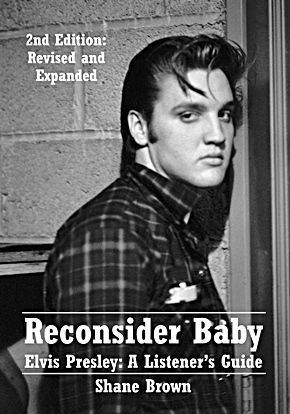 |
EIN: It's good to talk it you again about Elvis' musical side, it has been a while! Your first 'Elvis Presley Listener's Guide' came out in 2014 which EIN thought was an extremely thorough look at Elvis' musical legacy - so why do a second edition?
Shane Brown: That’s a bit of a long story. Basically, I wrote the Elvis book in 2014, published it, and then didn’t intend to do anything similar in the near future. But, in the end, I started work on A Listener’s Guide for Bobby Darin. I used the same format as the Elvis book regarding structure, but I indulged myself a lot more in my fascination with newspaper and magazine archive material. So, the Bobby Darin book ended up doing something the Elvis one didn’t – it had my own comments and thoughts on the music, but it also told the parallel story of how Darin (who, like Elvis, was often controversial, albeit for different reasons) and his career was discussed in the press during the 1950s through to the 1970s. It ended up being a better book for that, and I felt I wanted to revisit the Elvis book at some point and rework it in the same way. What we are led to believe about how music was received when it was released, or how TV shows were regarded when they were first broadcast, is not always the same as the reality, and this new edition is, I think, the first serious career-long study of “Presley in the Press.” I’m hoping some eyebrows will be raised!
 |
Elvis with Bobby Darin.
EIN: Your previous 'Elvis listener's Guide' was an impressive 330 pages, so how expanded will this one be?
Shane Brown: The new edition is 450 pages, BUT I have actually made the pages themselves bigger with this new version, and reformatted the text, to try and keep the number of pages lower, and therefore the cost at retail as low as possible. The first book was around 118,000 words, whereas the new one is around 198,000 words – so it’s about 66% longer, so an online calculator tells me!.
Still no photos, though, I might add. There are plenty of books out there now that cater for that market. I can’t compete with them, and it’s not what I do anyway. Putting some photos in a book like this would ultimately add nothing to it except a few pounds on the price.
I’m the first one to moan when an album is released with a couple of unreleased tracks on the end, meaning that, in order to hear them, you have to buy the whole thing again for just a small amount of new material. I didn’t want to be accused of the same practice with the second edition of the book. It was either going to be substantially expanded or not published at all. In the end, I’ve ended up cutting stuff out to keep it from being War and Peace.
EIN: What further research did you do for this edition and how long have you been putting it together?
Shane Brown: Most of the new research was done through various archives, digging up old newspaper, magazine and trade journal articles. The availability of such material is growing almost by the day, and there is significantly more of these archives around now than in 2014 when I did the first edition.
EIN: Where and how did you do this research?
Shane Brown: I did the research off and on over a period of about a year in between working on other projects, and then did the writing over the last six months. Most of the archives are online, if beyond paywalls, so it is possible to do most of the work from home – which is good, as health won’t permit me to travel!
EIN: Have you any idea how many new articles you have referenced in the second edition?
Shane Brown: There were 170 or so in the first edition. There are over 500 in the new one – and a couple of hundred beyond that which I didn’t use, mostly because they are about Elvis’s personal life (marriage, divorce, girlfriends in the 1950s, buying of Graceland etc), and that’s not what the book is about.
EIN: Wow, that is massive number of new references. Did you find reviews and articles about Elvis music that surprised you?
Shane Brown: More than you might imagine – but I have found that, as you go back over these kind of sources, you tend to find that what we have been led to believe over the years isn’t necessarily the whole story – and that’s the case not just for Elvis but for much of the cultural history of the 20th Century. One of the biggest surprises for me was the less-than-enthusiastic reviews that the 1969 Memphis albums got in the popular press. Another was that, while Elvis had hardly any press articles dedicated to him between 1965 and 1967 (aside from those covering his marriage), in 1968 there was this great flurry of serious pieces about him and his work – in some cases before the TV show was even made, and all of them at least two months before it aired. That was quite a surprise – to find that there was already a renewed interest in him at that time, and it had nothing to do with the NBC show.
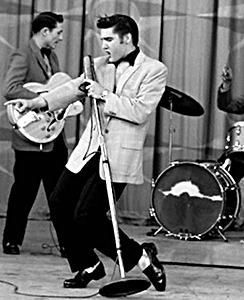
|
 |
EIN: As most fans assume the media’s increased interest in 1968 was due to the “Comeback” TV show that’s quite something. What about in the fifties?
Shane Brown: Perhaps most important is that I’ve managed to unearth enough new material from 1956 to be able to give far more detail than we have had before with regards to the attacks that Elvis came under following the second appearance on the Milton Berle show. This includes shedding light on Jack Gould’s long-running vendetta against Berle himself – Gould was the columnist who opened the floodgates for those attacks, and spurred them on. There’s also an interesting article from Screenland magazine, where a rather downhearted Elvis talks openly about the how the attacks had affected him:
‘I’ve kept every article written about me,’ Elvis says, ‘and some of them make me feel so bad I can hardly sleep. I shouldn’t let it worry me. But I can’t help it. What gets me really sore is the way they try to smear the kids who go for my stuff as delinquents. What are they so scared of? Why do they get so upset whenever teenagers get a chance to express how they feel? Reporters write that I eat ten hamburgers at a sitting or eight eggs for breakfast. ‘T’ain’t so. I been criticized for buying Cadillacs. Well, if I’ve got the money, why shouldn’t I? And people keep saying that my manager, Colonel Parker, has got a good thing in me. Sure he has. And I’ve got a good thing in him. We both make money.’
EIN: That's a great example. Do you think that overall - apart from the 50's outrage - that the Media understood Elvis' musical ambitions?
Shane Brown: Probably not – in the 50s, that is. But I’m not sure how many musical ambitions Elvis had. He seemed a lot more interested in making it as an actor in many of the interviews than progressing as a singer, and it is perhaps surprising how quickly some of the mainstream press started recognising his talents in that area and the improvements in his films. But it’s worth remembering that films got reviewed in newspapers back then much more than records.
EIN: In your previous book - albeit a great read - I felt that there were opinions that I wanted to argue with - obviously yours - so do you think the additional contemporary content widens the scope of the discussion?
Shane Brown: All opinions should be argued with! But you were not alone in doing so, that’s for sure. And I have emails to prove it! The contemporary reviews certainly add to the opinions on offer, that’s for sure – even if, sometimes, they aren’t going to be any more in line with yours (or anybody else) than my own are. But they are often eye-opening! And I’m still quite opinionated in the text, I’m pleased to say, such as when discussing the rock critics in the 1970s who refused to accept that Elvis changed musical direction.
EIN: Did further investigation change your original opinions about some of Elvis' work? Did you re-write some of your original text?
Shane Brown: To be honest, there isn’t a single section of the book that hasn’t been revised in some way – sometimes just wording, but often opinions and other content. I’m not sure the original articles changed my mind about things, but sometimes we revisit music and change our mind about it. Something like the 60CD set of original albums that came out last year can even do that. Hearing music in the sequence of an album can be quite a different experience to hearing it session by session, I think.
One thing I had fun doing was writing short reviews of all seventy original LPs together with thirty of the more essential posthumous releases, making what I call the “Elvis 100.” It’s added as an appendix at the back of the book. I surprised myself at some of the ratings I gave albums!
 |
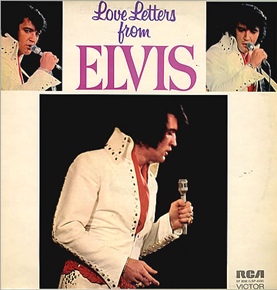 |
EIN: I cannot wait to read your “Elvis 100” rating list, what a great idea. I usually consider the “Love Letters From Elvis” album a real stinker, but then the studio jams on it ‘Cindy Cindy’ and ‘Got My Mojo Working” were gems, can’t wait to compare lists!
Shane Brown: The Elvis 100 was difficult, I have to admit. Especially as I wanted to include all US life-time LPs - even something such as Pure Gold. Do you rate that for some of the great tracks it contains, or the fact it's put together with no thought at all? The same is true of something like Love Letters, which, as you say, has a couple of stellar tracks, and a number that are...not. Something like Clambake was the worst to figure out. It's got 'Guitar Man' and 'Big Boss Man' and 'You Don't Know Me' - and it's got 'Confidence' and 'Who Needs Money'! I'm thinking fans will realise early on that I've factored in both the songs themselves AND how the LP works as a coherent album - or not!.
EIN: What about Elvis’ live concerts?
Shane Brown: As for the live albums released in the decades after Elvis's death, I have made an effort to include something from every post-comeback year. So, whereas I could have included four 1969 live albums, I didn't want that kind of repetition. So there is a 1976 concert release included, which will raise some eyebrows. Less and less bootlegs are essential these days, thanks to FTD, and so only one bootleg makes it to the list - Brightest Star on Sunset Boulevard. I don't think Sony have come remotely close to issuing anything as worthwhile as that from the That's the Way It Is rehearsals.
I also went back and re-listened to the 1950s live recordings that I had not spent much time on in the first edition.
EIN: Yeah, I was going to ask about those because in your first edition one point I took you to task for was stating that the September 1956 Tupelo Fairground concerts had "Limited interest due to the poor sound quality". I disagreed since I believe that even with poor recordings they present a fascinating document of the power of Elvis' performances at that time. Will your expanded edition make me happier with the author?!
Shane Brown: When Gordon Minto reviewed the book in Elvis: The Man and His Music, he was positive about it, but finished by saying that he wasn’t quite sure who it was aimed at. And I think he made a good point – and the way I dealt with the 1950s live performances in general is a prime example. If I was aiming the book at a general audience rather than the hardcore fans, then my comments about sound quality were probably fair enough – as a “Listener’s Guide.” But I tried to make the book all things to all people, and on that basis, it failed because it wasn’t detailed enough in some places for people such as yourself. So, this time around, I have approached the 1950s live recordings differently. I still comment on sound quality, as I think it’s important for some fans exploring the catalogue – but I have also commented on the music much more, the changes in repertoire, and, of course, reviews of those concerts from the time. There were only seven lines dedicated to those Tupelo concerts in the first edition, but there’s a page and a half in the new one.
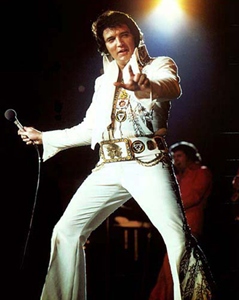 |
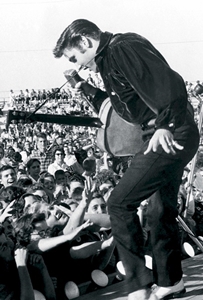 |
EIN: The media obviously lost interest in Elvis' recorded material after the early 1970's comeback. Did you find it difficult to track down additional interesting articles for the later section of the book?
Shane Brown: There are plenty of interesting articles from the 1970s, but many of them are about Elvis on stage rather than Elvis on record. Some people made comments about the first edition that I didn’t spend enough time with regards to Elvis’s live concerts in the 1970s beyond those professionally recorded, and so I have tried to address that this time around as well – and the newspaper reviews and articles allow me to do that. In many ways, the book has become a kind of career biography, told in the words of the media at the time, along with my own commentary on the music as before. I was hoping to include a batch of complete articles at the back of the book, but copyright issues were a problem – most notably getting copyright holders to reply. I think they call it “Elvis on Tour” syndrome!
EIN: How did you decide on the name of the new version?
Shane Brown: It is “Reconsider Baby. Elvis Presley: A Listener’s Guide.” The original book was always going to be called Reconsider Baby until I changed it a few weeks before publishing. This time, it made more sense to use that title – and to keep A Listener’s Guide as the subtitle to stop people thinking this is an entirely new book.
EIN: Will there be a paper edition?
Shane Brown: There will be both paperback and Kindle editions and it should be coming out mid-September and available through Amazon.
EIN: You have given me a brief look at one newly expanded chapter and I can tell you I am truly impressed. I am sure that any Elvis music aficionado will love it. I can't wait to read the finished product.
Shane Brown: Thanks, I will be sure to tell EIN readers as soon as it comes out.
For Purchase details please read EIN's book review.
- EIN note, the images used in the interview above are NOT from the book.
Interview by Piers Beagley.
-Copyright EIN August 2017
EIN Website content © Copyright the Elvis Information Network.
Click here to comment on this interview
Book Review "Reconsider Baby: Elvis: A Listener's Guide": Elvis Presley made over 700 recordings during his life. This book by author Shane Brown examines all of them. Session by session, song by song, Reconsider Baby takes the reader on a journey from Elvis’s first recordings in 1953 through to his last performances in 1977.
This significantly expanded and revised edition of 2014’s Elvis Presley: A Listener’s Guide provides a commentary on Elvis’s vast and varied body of work, while also examining in detail how Elvis and his recordings and performances were discussed in newspapers, magazines, and trade publications from the 1950s through to the 1970s.
The text draws on over 500 contemporary articles and reviews, telling for the first time the story of how Elvis and his career played out in the printed media, and often forcing us to question our understanding of how Elvis’s work was received at the time of release.
Can another detailed examination into Elvis' musical legacy really be worth buying? (Hint, the answer is a big YES!)
Go here as EIN's Piers Beagley reviews the newly expanded look into Elvis' musical legacy, including some choice book extracts...
(Book Reviews, Source,ElvisInformationNetwork)
|
 |
"Elvis: A Listener's Guide" First Edition EIN Interview with Author Shane Brown: Since Elvis's death in 1977, hundreds of books have been written about Presley, but very few concentrate on the most important thing: the music.
The new book by Shane Brown 'Elvis Presley: A Listener's Guide' discusses the remarkable and yet often frustrating legacy that Elvis left behind. Buy why do we need a new critique?
Author Shane Brown kindly agreed to be interviewed by EIN about his interesting new look at Elvis' music.
We ask..
- What insights does this new book bring?
- Was Felton Jarvis important?
- Was Col Parker good or bad?
- Do you really review every song Elvis recorded?
- What songs does he never want to hear again? and much much more
|
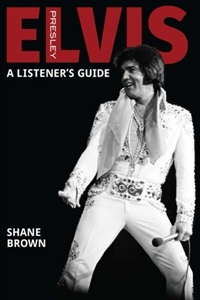 |
EIN Website content © Copyright the Elvis Information Network.
Elvis Presley, Elvis and Graceland are trademarks of Elvis Presley Enterprises.
The Elvis Information Network has been running since 1986 and is an EPE officially recognised Elvis fan club.
|
|













